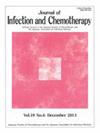由两个结核分枝杆菌亚克隆引起的内源性和侧枝再激活一例
IF 1.5
4区 医学
Q3 INFECTIOUS DISEASES
引用次数: 0
摘要
结核病(TB)的内源性再激活被认为是结核分枝杆菌亚克隆从初始分离物不断积累基因组突变的过程。然而,我们遇到了一个内源性再激活的病例,结核分枝杆菌从原发疾病中分离出来,并从原始克隆中分离出来。在一项回顾性队列研究中,对2012年和2020年日本山形市的一例复发性结核病病例进行了彻底调查。这包括对临床过程的评估,包括计算机断层扫描(CT)结果、回顾性接触者追踪、分子流行病学调查和结核分枝杆菌的全基因组测序。2012年和2020年CT示右肺不同区域新发病灶。回顾性接触者追踪和使用可变数串联重复分型的分子流行病学监测排除了外源性再感染。对2012年和2020年培养的两个结核分枝杆菌分离株的基因组进行比较,发现14个单核苷酸变体,每个变体积累了来自原始克隆的7个单核苷酸变体。这些发现提供了证据,证明结核分枝杆菌亚克隆在同一宿主内的不同肺病变中可以间接积累基因组突变。我们的病例报告表明,认识到侧支再激活的可能性可能会加强追踪传播途径的策略,并加深我们对耐药性演变的理解。未来的研究应侧重于在病理生理学和基因组微生物学证据的支持下,确定更多的侧支再激活病例。本文章由计算机程序翻译,如有差异,请以英文原文为准。
A case of endogenous and collateral reactivation caused by two Mycobacterium tuberculosis subclones
Endogenous reactivation of tuberculosis (TB) has been considered a process in which Mycobacterium tuberculosis subclones continuously accumulate genome mutations from the initial isolate. However, we encountered a case of endogenous reactivation that M. tuberculosis isolated from the primary disease and recurrence collaterally diverging from an original clone. In a retrospective cohort study, a recurrent TB case was thoroughly investigated in 2012 and 2020 in Yamagata, Japan. This included an evaluation of the clinical course, including computed tomography (CT) findings, retrospective contact tracings, molecular epidemiological investigations, and whole-genome sequencing of M. tuberculosis. CT imaging revealed new lesions in different regions of the right lung in 2012 and 2020. Retrospective contact tracings and a molecular epidemiological surveillance using variable-number tandem repeat typing ruled out exogenous reinfection. A genome comparison of two M. tuberculosis isolates cultured in 2012 and 2020 revealed 14 single nucleotide variants, with each accumulating 7 single nucleotide variants from the original clone. These findings provide evidence that M. tuberculosis subclones in different lung lesions within the same host can accumulate genome mutations collaterally. Our case report indicates that recognizing the potential for collateral reactivation may enhance strategies for tracing transmission routes and deepen our understanding of the evolution of drug resistance. Future research should focus on identifying additional cases of collateral reactivation, supported by both pathophysiological and genome microbiological evidence.
求助全文
通过发布文献求助,成功后即可免费获取论文全文。
去求助
来源期刊

Journal of Infection and Chemotherapy
INFECTIOUS DISEASES-PHARMACOLOGY & PHARMACY
CiteScore
4.10
自引率
4.50%
发文量
303
审稿时长
47 days
期刊介绍:
The Journal of Infection and Chemotherapy (JIC) — official journal of the Japanese Society of Chemotherapy and The Japanese Association for Infectious Diseases — welcomes original papers, laboratory or clinical, as well as case reports, notes, committee reports, surveillance and guidelines from all parts of the world on all aspects of chemotherapy, covering the pathogenesis, diagnosis, treatment, and control of infection, including treatment with anticancer drugs. Experimental studies on animal models and pharmacokinetics, and reports on epidemiology and clinical trials are particularly welcome.
 求助内容:
求助内容: 应助结果提醒方式:
应助结果提醒方式:


